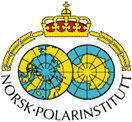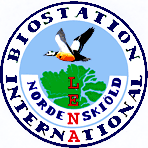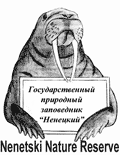Main publications of the project
Publications are available in pdf upon request for educational purposes. Write to nicolas.lecomte AT uit.no
Click on the paper title to get its abstract
Pokrovsky, I., Ehrich, E., Ims, R.A., Kulikova, O., Lecomte, N. Yoccoz, N. G.
Linking Weather Conditions and Nestling Mortality of an Arctic Raptor with Camera Monitoring
When food becomes scarce, the youngest nestlings in raptor species typically die and such events are usually attributed to siblicide. Here we present results from an investigation in Arctic tundra, where rough-legged hawk (Buteo lagopus) breeding success was monitored both with regular visits to nests and with time-lapse cameras recording the activity of chicks and their parents continuously. This led us to discover a new cause for hawk chick mortality linked to poor weather conditions rather than siblicide. Such link needs to be considered in light of climate change in the Arctic.
To download pictures link to Pokrovsky et al. 2010 submitted, click here
SUBMITTED PAPERS
2010
Lecomte, N., Ahlstrøm, Ø.,Ehrich, D., Fuglei, E., Ims, R.A., Yoccoz, N.G.
Population structure shaping stable isotope discrimination and turnover: experimental evidence in arctic foxes
Oecologia- abstract not available
2010
Killengreen, S.W., Lecomte, N., Ehrich, D., Schott, T., Yoccoz, N.G., Ims, R.A.
The importance of resource subsidies to an invasive mesopredator in th
Arctic tundra.
J Anim Ecol
1. Most studies addressing the causes of the recent increases and expansions of mesopredators in many ecosystems have focused on the top-down, releasing effect of extinctions of large apex predators. Here we provide evidence for the red fox expanding in Arctic tundra being linked to an increased provision of subsidies; hence a mesopredator release owing to bottom-up effect.
2. By employing two complementary methods of diet analyses (stomach contents and stable isotopes) on red foxes sampled across a coast inland gradient in different phases of a multi-annual small rodent cycle, we were able to investigate the seasonal dynamics and spatial pattern of red fox subsidy exploitation
3. We found that inland red foxes to a large extent subsisted on reindeer carrion in the bottleneck winter of the rodent low phase. Lemmings became the most important food item towards the peak phase of the rodent cycle, despite being less abundant than sympatric voles. Although marine resources were reflected in red fox isotopic signatures near coast in winter, marine subsidies did not spill over to adult foxes beyond 20-25 km from the coast.
4.We conclude that expansion of red fox into the Arctic tundra, at least regionally, is due to management-inflicted subsidies in terms of increased abundance of ungulate carrion.
PUBLISHED PAPERS (with abstract)
2010
Gilg, O. & Yoccoz, N.G.
Explaining bird migration. Science 327, 276-277.
Predation pressure falls with increasing latitude, helping to explain why many birds migrate as far north as the high Arctic.
2010
Ehrich, D., Tarroux, A., Stien, J., Lecomte, N., Killengreen, S.T., Berteaux, D. & Yoccoz, N.G.
Stable isotope analysis: modelling lipid normalization for muscle and eggs from arctic mammals and birds.
Methods in Ecology and Evolution, doi: 10.1111/j.2041-210X.2010.00047.x
1. Lipids are more depleted in 13C than proteins. Variable lipid contents in tissues affect therefore the measurements of stable carbon isotope ratios. Model based (also called mathematical) normali- zation has been suggested to correct d13C values using the ratio of carbon to nitrogen (C⁄N) as a proxy for lipid content. This approach has not been thoroughly validated for terrestrial animals and it is not clear to what extent it is generally applicable or species ⁄ tissue specific.
2. Ratiosofstablecarbonisotopes(d13C)wereobtainedformusclesamplesof22mainlyterrestrial arctic mammal and bird species and for egg samples of 32 bird species from nine sites in the circum- polar Arctic. We used linear and nonlinear equations to model the difference in d13C between samples from which lipids had been extracted chemically and bulk tissue samples. Models were compared on the basis of a model selection criterion (AIC) and of prediction error as estimated by cross-validation.
3. For muscle samples, a linear and a nonlinear equation performed equally well. The observed values were also well predicted by a previously published general equation for aquatic organisms. For egg samples, a nonlinear equation fitted separately to waterfowl and non waterfowl bird species fitted the data best. Prediction errors were, however, larger than for muscle samples.
4. The generality of the inferred normalization equations was assessed by applying them to a second data set from a similar ecosystem, but produced in the frame of another study. The predicted lean d13C values were within 0.5% per mil of the observed values for 73% of the muscle samples, but only for 27% of the egg samples.
5. Based on our results, we recommend model based normalization of d13C values as an economic way to deal with varying lipid contents in muscle samples of mammals and birds. For egg samples, on the contrary, model based predictions had large errors. Therefore, we recommend chemical lipid extraction in order to estimate lipid-free d13C values for egg content.
2010
Tarroux, A., Ehrich, D., Lecomte, N., Jardine, T., Bêty, J. & Berteaux, D.
Sensitivity of stable isotope mixing models to variation in isotopic ratios: evaluating consequences of lipid extraction. Methods in Ecology and Evolution, doi: 10.1111/j.2041-210X.2010.00033.x
1. Stable isotopes of carbon and nitrogen are increasingly used in studies of animal diet reconstruction via mixing models. However, isotope ratios of both consumer and source tissues can be altered by various amounts of lipids, potentially leading to biased estimates of diet composition when they are not taken into account.
2. We investigated the consequences of lipid correction on the estimation of diet composition with mixing models. Using empirical data from three northern terrestrial trophic systems, we illustrated the direct effects of lipid extraction on the δ13C and δ15N of source and consumer tissues and its ultimate effects on the reconstruction of the consumer’s diet.
3. In parallel, we developed a simulation tool in R, called Fatsim, to assess sensitivity of mixing models to variation in isotopic ratios of samples from source or consumer tissues. This tool can be used to assess the effect of shifts in isotopic ratios caused by lipid extraction, or other sources of variation, in any trophic system and thus aid in decision making regarding lipid removal.
4. Using Fatsim, we showed that the potential effects of lipid extraction on estimates of diet composition cannot be predicted without simulations, even in relatively simple systems. The sensitivity of a mixing model isotopic shift depends on the complexity of the system (number of sources) and on the relative positions of sources and consumers within the isotopic mixing space.
5. Our study confirms that the presence of lipids in tissues can bias the interpretation of diet reconstruction results. In a given trophic system, testing the sensitivity of a mixing model to lipid extraction can help decide whether lipid removal is required in order to avoid this bias.
2010
Pokrovsky, I., Lecomte, N., Sokolov, A. Sokolov, V. & Yoccoz, N.G.
Peregrine falcons kill a gyrfalcon feeding on their nesting. J Raptor Res, 44: 66-69
Competition between top predators is critical to the understanding of interactions in food-webs. However, there is little knowledge about the occurrence and consequences of competition among raptors breeding in the Arctic, partly due to the difficulties of observation inherent to that area. Tundra top predators, Gyrfalcon (Falco rusticolus) and Peregrine Falcon (Falco peregrinus) have often been observed interacting in the North American arctic but rarely in the Eurasian arctic, possibly because of the limited overlap of the nesting areas of Gyrfalcon and Peregrine Falcon in the European arctic. Here is to our knowledge the first report that Gyrfalcons can affect the reproductive success of Peregrine Falcons by killing nestlings, and that such predation is risky as the adult peregrines can harm or kill the Gyrfalcon. This case of aggressive interaction was unexpected because it happened outside the breeding range of Gyrfalcon, on theYamal peninsula in the Russian arctic.
2010
Lecomte, N., Ehrich, D., Yoccoz, N.G. & Ims, R.A.
Toward understanding the effect of top-predators on ecosystems.
F-1000 Biology Reports, 1:26-29
To what extent top predators - carnivores at the top of food chains - drive or just respond to ecosystem dynamics is a central, but partially unresolved, question in ecology. In this report, we highlight how different research approaches employed in aquatic and terrestrial ecology may have a bearing on how the role of top predators in ecosystems is perceived.
|

![]()






